Padmanabha is an epithet of the Hindu deity Vishnu. It may refer to:

The Padmanabhaswamy Temple is a Hindu temple, dedicated to Vishnu, in Thiruvananthapuram, the capital of the state of Kerala, India. It is one of the 108 Divya Desams, the sacred abodes of Vishnu in the Sri Vaishnava tradition. It is widely considered as the world's richest Hindu temple. The name of the city of 'Thiruvananthapuram' in Malayalam and Tamil translates to "The City of Ananta". The temple is built in an intricate fusion of the Kerala style and the Dravidian style of architecture, featuring high walls, and a 16th-century gopuram. While as per some traditions the Ananthapura temple in Kumbla in Kasaragod district in Kerala is considered as the original spiritual seat of the deity ("Mulasthanam"), architecturally to some extent, the temple is a replica of the Adikesava Perumal temple in Thiruvattar in Kanyakumari district in Tamil Nadu.

The Undavalli Caves, a monolithic example of Indian rock-cut architecture and one of the finest testimonials to ancient viswakarma sthapathis, are located in Vijayawada of Guntur district in the Indian state of Andhra Pradesh. The caves are located south west of Vijayawada, 22 km north east of Guntur City of Andhra Pradesh. It is one of the centrally protected monuments of national importance.
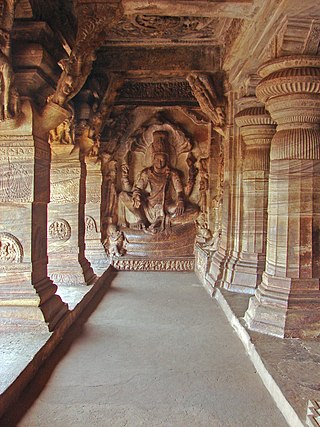
The Badami cave temples are a complex of Hindu and Jain cave temples located in Badami, a town in the Bagalkot district in northern part of Karnataka, India. The caves are important examples of Indian rock-cut architecture, especially Badami Chalukya architecture, and the earliest date from the 6th century. Badami is a modern name and was previously known as "Vataapi", the capital of the early Chalukya dynasty, which ruled much of Karnataka from the 6th to the 8th century. Badami is situated on the west bank of a man-made lake ringed by an earthen wall with stone steps; it is surrounded on the north and south by forts built during Early Chalukya and in later times.

Arulmigu Murugan Temple, Thiruparankundram is a Hindu temple dedicated to the god Murugan at Thiruparankundram, Tamilnadu, India. It is regarded as one of the "First Houses of Murugan". The temple uses rock-cut architecture and is believed to have been built by the Pandyas during the 6th century. According to legend, Murugan slayed the demon Surapadman and married his consort Devasena at the temple. Murugan is also said to have worshipped his father Shiva at the site as Parangirinathar.
Sri Raja Rajeshwara Temple is one of the most famous Hindu temples in Telangana, India, dedicated to Lord Shiva. It is located in the town of Vemulawada, Telangana, India. Historically the region was the capital of the Vemulawada Chalukyas who ruled from 750 to 973 CE.

Ananthapadmanabhaswamy Temple or Ananthapura Lake Temple is a Hindu temple in the middle of a lake in the village of Ananthapura, around 6 km from the town of Kumbla in Manjeshwaram Taluk of Kasaragod District of Kerala, South India. This is the only lake temple in Kerala, and as per some traditions, is believed to be the original seat (Moolasthanam) of Ananthapadmanabha Swami Thiruvananthapuram. It is considered one among the 108 Abhimana Kshethram of Vaishnavate tradition. Legend has it that this is the original site where Ananthapadmanabha settled down.

Temples of North Karnataka

An onavillu is a simple, short, bow-shaped musical instrument. Its name may come from Onam, a festival in Kerala where the instrument is used in dances, and villu, which means 'bow' in Malayalam. Although still regularly used in rural art forms, use of the onavillu is on the decline.
The Mithrananthapuram Trimurti Temple is a Hindu temple complex in Thiruvananthapuram, Kerala, India. It is a temple in where devotees get to offer worship to all the three Trimurti deities, namely,. The Temple is located on the western side of Padmanabhaswamy temple in Thiruvananthapuram.
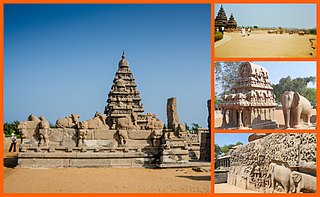
The Group of Monuments at Mahabalipuram is a collection of 7th- and 8th-century CE religious monuments in the coastal resort town of Mahabalipuram, Tamil Nadu, India and is a UNESCO World Heritage Site. It is on the Coromandel Coast of the Bay of Bengal, about 60 kilometres (37 mi) south of Chennai.

Ananthagiri Hills is located in Vikarabad district, Telangana, India. The water flows from these hills to Osman Sagar, also known as Gandipet lake, and Himayathsagar.
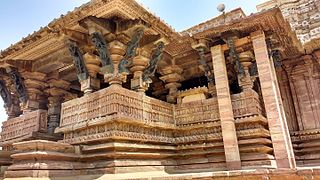
The earliest temples in Telangana include the Alampur Navabrahma Temples built during the 6th century CE by the Badami Chaulukyas.
The Telangana State Tourism Development Corporation is a state government agency which promotes tourism in Telangana, a state in the Southern region of India. The retired Director General of Police Pervaram Ramulu is the appointed First chairman of Telangana State Tourism. Tourist attractions in Telangana include historical places, monuments, forts, water falls, forests and temples.
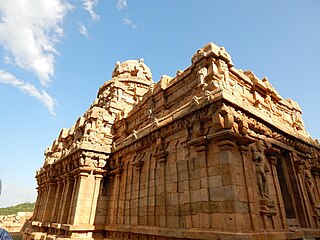
Vijayalaya Choleeswaram in Narthamalai, a panchayat town in Pudukottai district in the South Indian state of Tamil Nadu, India, is a temple dedicated to the Hindu god Shiva, Vishnu and houses the 8th century Jaina Abode. The temple is considered one of the oldest stone temples in South India. The other portions of Narthamalai houses the 8th century Jaina Abode, the Aluruttimalai Jain Caves. The Temple is Constructed in the Dravida style and rock cut architecture, the temple is believed to have been built during the 9th century by Mutharaiyar dynasty kings, the cardinals of Pallavas, with later expansion from the Cholas. The rock-cut architecture is an early example of Cholan Art, continuing the tradition of the Pallavas.

The Narasimhaswamy temple in Namakkal, a town in Namakkal district in the South Indian state of Tamil Nadu, is dedicated to the Hindu god Narasimha, an avatar of Vishnu. The temple is one of the 108 Abhimana Kshethrams of Vaishnavate tradition. Constructed in the Dravidian style of architecture and Rock-cut architecture, the temple is located in the Salem–Namakkal–Trichy Road. The legend of the temple is associated with Narasimha, an avatar of Hindu god Vishnu appearing for Lakshmi, his consort, and Hanuman. Based on the architectural features, historians believe that the temple was built during the 6th century by the Adiyamans also called Satyaputras as evident from the inscription mentioning the temple as 'Adiyendra Vishnu Gruham' or 'The house of Vishnu of the Adiyaman kings'.
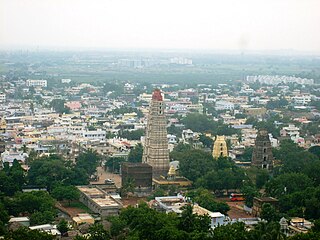
Mangalagiri Tadepalli Municipal Corporation (MTMC) is the civic body that governs Mangalagiri and Tadepalle city's and villages in the corresponding mandals of the Mangalagiri Assembly constituency in Guntur district of Andhra Pradesh. It is the second largest municipal corporation next in line to GVMC in terms of area with 194.41 km2 (75.06 sq mi) and 2,53,875 of voters in the state of Andhra Pradesh. It is classified as important Municipal Corporation in the Capital of Andhra Pradesh. Municipal Corporation mechanism in India was introduced during British Rule with formation of municipal corporation in Madras (Chennai) in 1688, later followed by municipal corporations in Bombay (Mumbai) and Calcutta (Kolkata) by 1762. Mangalagiri Tadepalli Municipal Corporation Municipal Corporation is headed by Mayor of city and governed by Commissioner.

Pallikonda Perumal Temple is a Hindu temple dedicated to the deity Vishnu, located at Malayadippatti in Kulatthur taluk of Pudukkottai district in Tamil Nadu, India. This is a small village and one of the important rock cut temples of Pudukkottai district such as Thirumayam Rock cut temple. The Dvarapala's have only 2 hands unlike the other Dvarapala's who have 4 hands in other Vishnu temples.
The Yogananda Lakshmi Narasimha Swamy Temple, also known as Mattapalli Narasimha Temple, is a Hindu temple dedicated to Narasimha, the half-man half-lion avatar of Vishnu, and his consort Lakshmi. It is located in Mattampally, a village in the Mattampally mandal of Suryapet district in the Indian state of Telangana. One of the Pancha Narasimha Kshetras, the temple is located on the banks of the Krishna River, and was built in the 11th century by Anumala Machi Reddy, the king of Thangedu region after the deity appeared in his dream and instructed him to do so. The main shrine houses a swayambhu (self-manifested) idol of Narasimha as Yogananda Lakshmi Narasimha, and was worshipped by sage Bharadvaja and other seers for hundreds of years before the temple was constructed. Lakshmi is worshipped here as Rajalakshmi Thayar and Chenchu Lakshmi Thayar.














